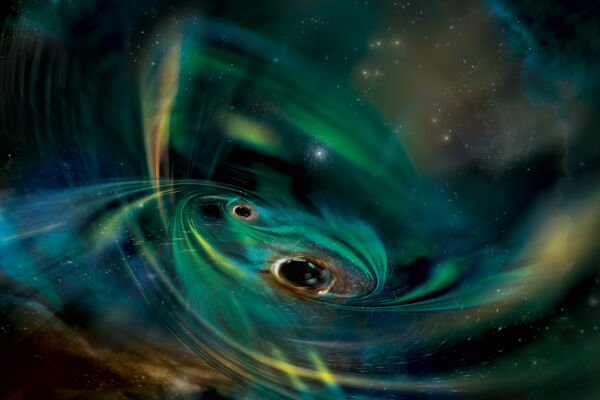Astronomers have discovered two massive black holes in a distant galaxy located 1 billion light-years away from Earth, stirring up clouds of gas and causing a continuous phenomenon. The combined mass of these two black holes is equivalent to 40 million times that of the Sun.
According to a press release issued by the National Aeronautics and Space Administration (NASA) on November 13, astronomers using NASA’s Neil Gehrels Swift Observatory have for the first time detected signals of a pair of giant black holes at the center of a galaxy disturbing surrounding gas clouds.
Lorena Hernández-García, an astrophysicist from the Millennium Institute of Astrophysics and the University of Valparaíso in Chile, stated that the peculiar event known as AT 2021hdr repeats every few months.
Hernández-García explained that they believe the gas clouds engulfed the two black holes. As the black holes orbit each other, they interact with the gas clouds, stirring and depleting them, producing oscillations in the emitted light.
These black holes are located at the center of a galaxy called 2MASX J21240027+3409114, situated in the Cygnus constellation, 1 billion light-years away from Earth.
The distance between these two black holes is approximately 16 billion miles (26 billion kilometers), close enough that light only takes a day to travel between them. Their total mass amounts to 40 million times the mass of the Sun.
Astronomers estimate that these two black holes complete a full orbit every 130 days and are likely to collide and merge within about 70,000 years.
In 2021, astronomers first discovered AT 2021hdr using the Zwicky Transient Facility at the California Institute of Technology. Since then, they have observed similar events every 60 to 90 days.
Hernández-García and her team started observing AT 2021hdr in November 2022. Initially, they thought the signal they detected might be a byproduct of normal activity at the galaxy’s center. Subsequently, they explored the possibility of the destruction of a star located too close to the black holes as a potential cause.
Ultimately, they identified another possibility, a tidal disruption event of a gas cloud, where the disruptive forces of tidal forces are greater than the damage caused by the binary black holes themselves.
When the gas cloud encounters these two black holes, gravitational forces tear the cloud apart, forming filaments around the black holes, and the heat generated by the friction heats up the gas, making it exceptionally dense and hot near the black holes.
As these two black holes move along their orbit, the intricate interplay of forces ejects gas from the system with each rotation. These interactions ultimately create the observed fluctuating light for astronomers.
Hernández-García and her team plan to continue observing AT 2021hdr to gain a better understanding of the system and improve their models. They are also interested in studying the parent galaxy of the system, which is currently merging with another nearby galaxy.
Bradley Cenko, the Chief Scientist at the Neil Gehrels Swift Observatory, expressed astonishment at the observatory’s continuous support for new research as it approaches its 20th anniversary. He emphasized the importance of the observatory in guiding our understanding of the ever-changing universe.
The research findings were published on November 13 in the journal “Astronomy and Astrophysics.”

